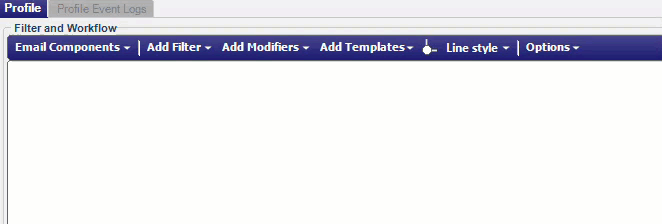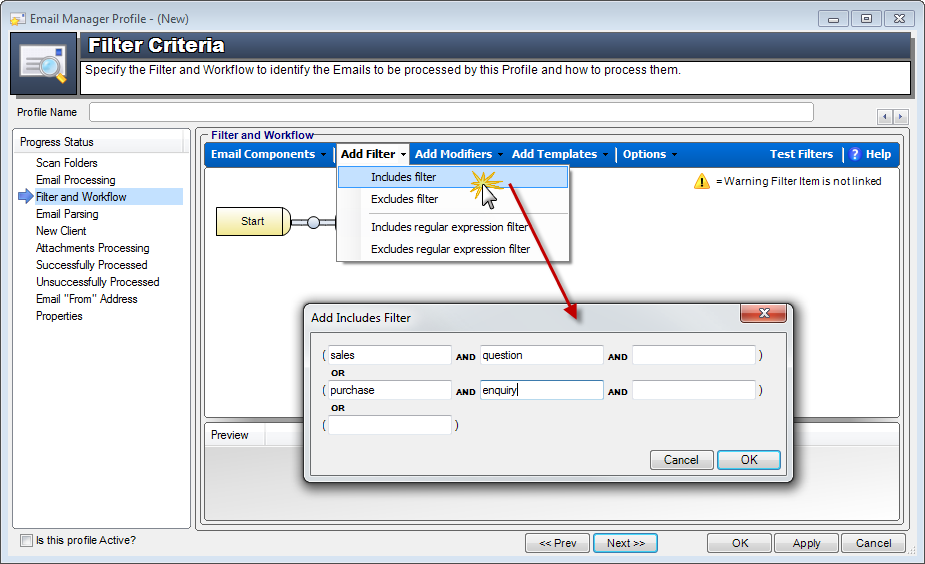Email Manager filtering email
Filtering, sorting and scanning email is one of the most important and central concepts of email automation, and the Email Manager contains a very powerful and sophisticated filtering system. This system will allow you to be able to pinpoint the exact type of email that you wish to process via an intuitive and visual filtering interface.

The Email Manager allows you to define an unlimited number of search terms that will filter the incoming email. Filtering is performed by building up a set of filters that scan different parts of an email (From, Subject, Message). Build filters based around simple Boolean logic (AND / OR), or use Regular Expressions for even more options.
Once the filtering logic is defined, use one or more template(s) to process the email. These templates can be Job Templates (for new jobs), or Action Templates (to update an existing job)
Define and build the filters
Use the toolbar to select the different types of filter components and options to build up your filter logic.

Select the email component to filter
The first step in designing an appropriate filter is to decide what part of the email to filter. To add an email component you wish to filter, select it from the “Email Components” drop-down box. Use multiple email components to build more complex filtering rules. eg. Filter on the “Subject” AND the “From” address. Use the Email Manager filters to target the following components of an email:
Subject Refers to the subject of the email
Message Refers to the body of the email. This may be plain text, or HTML depending on the configuration of your email system
Subject or Message Refers to the subject or the message as a combined object. If one of these components is a match then the filter will pass
Subject and Message Refers to the subject AND the message as a combined object. If both of these components match, then the filter will pass
From address Refers to who sent the email
To address Refers to the TO recipients
CC address Refers to the CC recipients
Attachments Refers to any files that are attached to the email. Attachments (attached or embedded) are NOT scanned in any way by any filters. When an email that does have attachments is converted into either a new job, these can be linked to the job/action. For further information about attachment processing see Attachment Processing
Specify what to look for and/or exclude
Filters can be joined together to create complex filtering rules.
Includes Use this to check whether the email contains a word, or group of words. Multiple terms can be defined using Boolean logic operators of AND and OR.
Excludes Use this to ensure that an email does not contain a word, or group of words. This type of filter is useful to limit, or exclude emails from further processing. Multiple terms can be defined using Boolean logic operators of AND and OR.
Includes Regular Expression Use a regular expression to create an “Include” style filter. This is useful when you have a complex filter, or need the extra filtering power of a regular expression.
Excludes Regular Expression Use a regular expression to create an “Exclude” style filter. This is useful when you have a complex filter, or need the extra filtering power of a regular expression.
Using Filters
Filters are used to filter Email Components and must be linked to at least one Email Component (see section above). Once a filter has been created, link the 2 components by clicking on the end of one component and drawing the connecting line to the start of the other.

Multiple filters of different types can be created and linked together in the one Email Manager profile. Creating different filter branches are useful when used in conjunction with Template Modifiers.
Case Sensitivity
The filters that you set with the Email Manager are not case sensitive. This means that..
- “SQL Server” is the same as “sql SERVER”
- “helpdesk” is the same as “HELPDESK”
- UpPeR CaSe is the same as uPpEr cAsE
Create filters for different purposes
The Email Manager has the ability to log a new HelpMaster job, add an action to an existing job, or simply move an email from one email folder to another. With this in mind, it is important to set filters that will “trap” emails that are intended for each of these different actions.
Filtering email for logging a new job
The main goal in designing filters for new jobs is to focus on keywords that will appear in either the email subject, message or both.
Filtering email for updating an existing job
Creating filters for the purpose of updating an existing HelpMaster job requires special attention. For example, consider what happens to an email when it is sent, and then replied to. Usually when an incoming email is the result of a “reply” action, the letters “RE:” will be appended to the start of the original email subject to denote that the email is a reply. With this information, you could set a filter on the Subject line of the filter to look for the letters “RE:”. If the subject also happens to contain an existing HelpMaster job number, then this email would be a good candidate for adding to an action as part of a job update.
In this case, a subject filter that “looks for” both “RE:” and your unique way of identifying your job number as per your outgoing email template (eg. “Job #”) would be appropriate filters for a profile designed to update an existing HelpMaster job.

Conversely, an email that has a subject that does not start with the letters “RE:” is usually a new email - not the result of a reply. This email may be suitable for logging a new job. In this case, your subject filter may specifically look for email that does not have “RE:” in the subject.
Complex filtering and filter processing order
It is possible to create complex filtering systems that have multiple branches. In such occasions, the Email Manager will process the filter branches in the order in which they were created. If this is not desireable, it is possible to re-order the processing order of the filters by right-clicking on a filter and selecting “Prioritize filter in current branch level”. This will promote this filter to be the first filter that will be processed for the level that the filter appears in.

Use the list at the bottom of the screen to verify the filter processing order. Click on a filter to see the filter path taken.
Drag an email from Microsoft Outlook onto the test section to check a profile. Click the “Test” button.
Text extraction and its effect on filters
Note! The message filters for each Email Manager profile are affected by the text-extraction options set here. When the filtering logic is processed for the “Message” part of the email, the Text Extraction options set here will be evaluted first, and then the filters will be evaluated. This allows you to configure filters that only relate to the extracted text from the email. Use the “Test” button on the filters to verify the filtering behaviour.
Deleting a filter
Right-click on an email component to delete it.
See Also
Templates
Job Templates (for new jobs)
Action Templates (to update an existing job)
Feedback
Was this page helpful?
Glad to hear it! Please tell us how we can improve.
Sorry to hear that. Please tell us how we can improve.